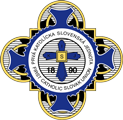Michael J. Kopanic, Jr., Ph.D.
Fašiangy, literally meaning “carnival,” is the Slovak word for Shrovetide or the French equiv-alent “mardi gras.” In Slovak traditional village life, fašiangy played out as a wild celebration of relentless feasting with sumptuous meals, costumed parades, singing, and dancing. It amounted to a very emotional release of pent up energy before Ash Wednesday (Popolcová streda), which marked the start of the holy season of Lent (Pôst).
Origins
The word “carnival” dates from Ancient Roman times; its origins derive from the Latin phrase carnem levare, meaning “withdrawal” or “removal” of meat, a reference to the Medieval Lenten fast from all animal products. The Slovak word fašiangy was borrowed from the German word der Faschung. Some experts believe that the German word for the carnival comes from the ancient Germanic word Vasen, or “running around crazily,” which was what literally happened in the days leading up to Lent. Other etymologists trace the origins of Fašang from the old Germanic word vast-schanc, meaning in modern German Ausschank des Fastentrunks (the pouring of the fasting drink). Unlike the Slovaks, the Czechs continue to use the word masopust (meaning fasting from meat), which originated in the era of Great Moravia in the 9th century.
Traditionally in all of Christian Europe, Lent represented a time of very intense fasting and prayer. The Church prohibited all types of merry-making; no parties, weddings, or other such celebrations were permitted during Lent. Fašiangy offered one last chance for merriment and prankish amusement before the onset of the holy season of meditation on one’s sins.
In general, the fašiangy celebrations in Slovakia started immediately after the January 6 Feast of the Epiphany, which Slovaks call Three Kings’ Day (Traja králi). Many weddings took place between January 7 and the beginning of Lent — because of the seasonal nature of agricultural work, people had more spare time. Fašiangy could be long or short, depending on when Lent started on the calendar. Over the long, cold winters, Slovaks occupied themselves doing mainly indoor activities and crafts, and also having some fun. Just as Americans today party at Super Bowl time, many Slovaks literally became party animals during fašiangy, especially during the last few days before Lent (ostatky).
While fašiangy technically started in January, the majority of the merrymaking occurred from the Sunday before Lent until Fat Tuesday (Tučný utorok), and sometimes well into Ash Wednesday morning. Frequently a wedding initiated the festivities. Musicians played and people danced from afternoon until early morning.
Formerly in the towns, the craft guilds played a leading role and sponsored various games and masquerade balls during fašiangy. The guilds organized competitions and used success in the games to select new apprentices. Journeymen also selected new master craftsmen during the ceremonies, which usually took place at the town hall. With the decline of craft guilds after industrialization, the balls and dance parties continued as a tradition.
Fašiangy Foods
The consumption of huge amounts of food and drink characterized fašiangy. Slovaks always drank alcoholic beverages at any social occasions, and during carnival time, they filled their glasses over and over with whiskey, plum brandy (slivovica), wine, and beer. In previous centuries, a favorite Slovak beverage was medovina, an alcoholic beverage made from fermented honey. In homes, women roasted meat and might put it on a spit to offer visitors. The ladies made bravčová huspenina (a pork jelly) and baked záviny (strudel); they fried fánky (light, fried pastries, called čeregy in Spiš dialect), šišky (filled pastries, called pankušky in Spiš dialect) or pampuchy (a kind of fritter, often from potatoes, since potatoes (zemiaky) were a mainstay of the simple Slovak diet. (My mother used to complain that as a girl she had potatoes for breakfast, potatoes for lunch, and potatoes for dinner!).
This tradition of fašiangy baking took place in both the cities and the villages of Slovakia. Similar customs were practiced in almost all Europe-an nations, and many people also placed baked goods on graves of their deceased relatives and beloved.
Fašiangy Parade and Visits
Typically a happy group of costumed and masked youths strutted from house to house playing music, sometimes accompanied by a band. They dressed up as outrageous or scary characters, such as a slameník (strawman), bakus (Bacchus the Roman god of feasting), kurina baba (an old lady), or a skeleton (kostra). Common animals imitated included a koza (goat), a medveď (bear), a wolf (vlk), and especially the turoň (an ox or some other type of cattle). Revelers made a turoň by having a young man hoist a companion on his shoulders; they would cover themselves with a large sheet or blanket, and then place a sewn head of an ox or bull with bells on the head of the guy on top. Then the group of masked marauders would saunter around the village and go from house to house. As they made their rounds, they would throw some manure on the way in order to leave a sign of their passing by, and the team leader would strike up some hearty and jovial folk songs. When they visited inside someone’s home, they might carry with them a vessel of cow dung, which they claimed was cattle blood. This was not meant to be an insult as we might think if someone brought dung into our homes. Rather Slovaks interpreted this as fortuitous, for this was a sign the household would enjoy the fruits of dung – a bountiful and fruitful harvest.
During the visits, the spirited youths might recite short poems or sing songs to the unmarried young maidens of the household. The lady of the house (gazdiná) would offer the vivacious visitors slanina (smoked bacon), udeniny (smoked meats), and other treats that were prohibited during Lent. Some of the young men dressed in drag as women and parodied and mimicked members of other ranks in society. For example, they might wear an animal skin, or some of them would dress like a žobrak (beggar) in torn up pants and a ragged shirt, and stuff themselves with straw. The costumed youths would frolic about clumsily, stagger, slide, and fall on the ground in front of the onlookers. The goofiest and most humorous character of group was often named Kubo or Starý (old man), just as in the jasličkáre (Bethlehem plays) from the Christmas season.
The young merrymakers also might each be equipped with a stick hewed from a branch, a basket, jingling bells, and one in the group would play a harmonika (accordion). They would sing ludicrous songs and shout out outrageous and humorous sayings and speeches. At the many homes they visited, they would collect lots of eggs, bacon, and a few groše (coins of small value). In some villages, a home or the local krčme (taverns) would roast a pig and feature a live band, which the youths would pay for with the money and goodies that they had collected in the village.
Ženy (The Ladies)
In addition to baking, some women also participated in the festivities. They would visit several homes, usually where some priadky (spinning) was taking place. (Spinning thread and making clothing were some of the main jobs women performed during the winter time. Women did this in groups, so it was a chance for them to socialize.) There they would drink “na vysoký ľan,” i.e., for tall flax, a main material for their work. In order to ensure that the flax grew long, the women would pull the hair of the lady whose hair was longest. Then they would jump up from their benches and perform a special dance.
Women and men also used fašiangy to apply some social pressure to the unmarried maidens. They joked about those girls who had not yet found a husband, especially the older girls. For instance, the ladies might sing a song that this girl thought she was too good for any of the eligible bachelors. Thus fašiangy reinforced the strong belief in marriage as a necessary and desired institution which all should aspire to. Gossip provided social pressure to marry.
When paraders visited a house of a young eligible girl, the men might typically dance with her and her mother. As a reward, they might receive some eggs, bacon, potatoes, flax, or rye into a basket that the frolickers carried with them. The gazda (head of the household) would offer a toast of “na zdravie” (to your health).
The Deceased
Another aspect of fašiangy was dedicated to honoring the deceased. Ancient pagans wore masks to remember their connections with their past. Pagan Slavs had burned their dead and smeared ashes on their heads to symbolize the continuity of spirit between them and their ancestors. The Church later adopted and Christianized the custom, which became known as Popolec (The Day of Ashes) or Popolcová streda (Ash Wednesday). When the ceremony was moved to the Halloween period, the masks remained, but the church modified the commemoration by replacing it with “All Saints Day,” followed by “All Souls Day” in November.
On Ash Wednesday and during Lent, those rowdy ones who had gone a little too far in their merrymaking would have a chance to go to confession and seek remission for their sins. The time of fasting and prayer had begun.
Traditional Fašiangy Songs
Singing was and is an integral part of the fašiangy celebration. Here is a short excerpt from a song typically sung by groups of young revelers who parade the streets. This rendition comes from what was formerly called Hont County, in central Slovakia not far from Zvolen. The boys would enter the house, raise a branch to the ceiling, spin around and sing:
Fašiangy, Turice, Vel’ka noc príde,
kto nemá kožucha, zima mu bude.
Ja nemám, ja nemám, len trasiem
dajte mi slaniny, že sa vypasiem.
A tam hore na komore, sedí kocúr na slanine,
choď’te si ho odohnali, a mne kúsok odrezati,
a to taký kúsok, ja pečená hus.
Ak sa máte porezať, idem si sám odrezať
a tak pekne zarovnám, že vám kúska nenechám.
Translation:
Fašiangy, Pentecost, and Easter will come,
whoever does not have a fur coat, will be cold.
I don’t have one, no I don’t, I’m just shivering,
Give me some bacon, so I can eat my fill.
And there up in the cupboard, a tomcat sits on the bacon,
go chase him away, and cut me a little piece,
oh, such a piece, I’ll have baked goose.
If you have to cut it, I’m going to cut it myself.
And I will slice it straight so nicely, and I won’t
leave you a little piece.
One will find different versions and verses of this frolicking fašiangy song, but they all contain common themes of food, feast, and utter nonsense.
For those who wish to hear the above tune and see a sample contemporary fašiangy celebrations, the internet offers several homemade recordings at the following YouTube websites. The second is from the city of Rimavská Sobota in southern Slovakia and features the above song. The third comes from the village of Tužina, in the Nitra district. The fourth is from the hamlet of Fačkov in central Slovakia. These and other sites can be found with a simple Google search using “fašiangy youtube ” as search words.
Fašengy, Turice, Veľká noc ide, https://www.youtube.com/watch?v=6d5KPFhXJfc –
This features mainly video in Slovak and has the first verse from the above song.
FAŠIANGY, Rimavská Sobota, 12.2.2010 http://www.youtube.com/watch?v=OKtrQ9WsUmY
FAŠIANGY v Tužine 2010 prológ http://www.youtube.com/watch?v=yJ4CcSuBpms
Fašiangy Fačkov http://www.youtube.com/watchv=SIRRkFLVrvw&feature=related
Pochovávanie basy – Burying the Double Bass
When the frolicking finally neared an end and Ash Wednesday was nigh (and the celebrants have consumed nearly all the food and imbibed all the drink), the festivities ended with the burying of the double bass (pochovávanie basy). The merrymakers would suddenly turn sad and burst out in a farcical bout of grieving, for the party is ending and the fasting of Lent lay ahead.
Finally, the merrymaking would end with villagers performing a parody of a funeral which buried their music, in which the bass loomed large. The dear bass was placed on a table or put on the floor “na máry,” on a funeral bier. The participants set burning candles around the bass. The merrymakers would disguise themselves as a priest, a sacristan, a psalmist, an organ player, and a gravedigger. By pretending that the bass had died, they reminisced about it, how it served them well, and how it contributed to their song and dancing. Now it had passed away. Many women present would carry on by mimicking mourning and let out a wailing lament, even though some might be laughing at the same time, all in good fun. This represented the bass’s send off to the “other world” and concluded the fašiangy festivities.
In the northern region of Orava, the burying of the contrabass ended with this lament.
“Už sa fašang krati, už sa nenavrati,a dievčence plačú, že sa nevyskačú.”
“The Carnival is passing by, it isn’t coming back, the girls are crying, because they won’t be jumping anymore.”
Conclusion — The Tradition Continues
Fašiangy was and is a time of fun and nonsense, but it has served an important purpose. People could vent their merriment in a socially acceptable way before the strictly observed six week Lenten fast. It helped them get through the hard winters of Slovakia.
While fašiangy festivities declined somewhat after World War II, especially in southeastern Slovakia, there has been a revival of the custom in recent years. Local branches of the Matica Slovenska (the Slovak Cultural Society) have sponsored some of the activities and ceremonies. In many towns, fašiangy has become a more organized venture.
But more people are getting involved now. Children go to school dressed in a costume for school rather than on Halloween as in the USA. On the last days of the season, costumed young people and jolly adults still parade around many villages, singing and celebrating. Some households again invite the groups in for a shot of brandy or whiskey, some sweets, and on occasion, even some homemade sausages.
Fašiangy today also features the staging of many semi-formal balls and dances. Men don their best suits and women wear colorful dresses, and dancing usually continues well into the morning. Many of the songs are more modern, especially from the 1970s and 1980s. The occasion usually includes plenty of drinking, two bountiful meals as well as an array of snacks.
In many cities after the War, the celebration had become little more than frying šišky and attending balls. But even that is changing. In the Slovak capital of Bratislava, the city annually stages a full-fledged parade of people in costume, and that is expanding in popularity as an-other reason to party. And other cities like Nitra have started following this example of parading and partying.
Even in some parts of the USA and Canada, the tradition has also revived. Some churches, ethnic cultural organizations, and Slovak radio clubs hold fašiangy balls. In Johnstown, Pennsylvania, the Slovak Heritage Society of the Laurel Highlands hosted a fašiangy feast in which attendees came in costume on March 5, 2011, and Slovak Canadians celebrated a masquerade ball in February 2015. And many other organizations as well have strove to keep the tradition. Our Jednota newspaper reminds of this treasured tradition. The fašiangy tradition is alive and well!
Sources
Benusova, Elena, “TRADITION OF FAŠIANGY IN ORA-VA” Slovak Heritage Live newsletter Volume 6, No. 1, Spring 1998, http://www.slovakheritage.org/Folkcustoms/fasiango-rava.htm(Accessed Jan. 28, 2017).
Bruncak, Jan, “Celebration of Fasiangy,” https://wwwbehance.net/gallery/475969/Celebration-of-Fasiangy (Accessed Jan. 28, 2017). The article copies part of Dr. Kopanic’s previously published article, but features Mr. Bruncak’s unique photos.
“Carnival, or Fašiangy, symbolises time of merriment and feasts,” Slovak Spectator, Feb. 12, 2016, compiled by Zuza-na Vilikovská, https://spectator.sme.sk/c/20092675/carnival-or-fasiangy-symbolises-time-of-merriment-and-feasts.html (Accessed Jan. 29, 2017).
Celebration of Fasiangy: Photography. Published: April 7, 2010. https://www.behance.net/gallery/475969/Celebration-of-Fasiangy (Accessed Feb. 9, 2016).
Fašengy, Turice, Veľká noc ide, Uploaded on Oct 30, 2011 by Štefan Bartko, YouTube video, https://www.youtube.com/watch?v=6d5KPFhXJfc (Accessed Jan. 27, 2017).
“Fašiangy,” Slovak Heritage Society of NEPA, http://www.shsnepa.org/Folktales%20and%20Legends/Seasonal/Spring/Fasiangy.htm (Accessed Jan. 28, 2017).
“Fašiangy or Winter Carnival,” JARMILASCOOKING. February 27, 2015. https://cookslovak.com/2015/02/27/fasiangy-or-winter-carnival/ (Accessed Feb. 9, 2016).
“FAŠIANGY, Rimavská Sobota, 12.2.2010.” YouTube. (Accessed Feb. 18, 2015). https://www.youtube.com/watch?v=OKtrQ9WsUmY .
“Fašiangový sprievod obcou Šúrovce.2008,” Uploaded on Nov 16, 2010 by SRbelamy, https://www.youtube.com/watch?v=gwJnCPFqQAY (Accessed Jan. 28, 2017).
“Fašiangy Traditions in Slovakia,” http://cpelcastell.edu. gva.es/z_comenius/ep/FASOSlovakia/Fasiangytraditionsin-Slovakia[1].htm (Accessed Feb. 18, 2015). This website heavily borrowed from my Jednota article and posted on this website.
“Fašiangy, Turíce…” YouTube, Published on Feb 15, 2013 by Televizia Prievidza, https://www.youtube.com/watch?v=VnYYIUDalW0 (Accessed Jan. 27, 2017).
“Fašiangy, Turíce, Veľká noc ide…,” bbonline.sk, Feb. 5, 2011, http://bbonline.sk/fasiangy-turice-velka-noc-ide%E2%80%A6/ (Accessed Jan. 29, 2017).
Feglová, Viera, “Calendar Customs,” Slovakia: European Contexts of the Folk Culture, Stolicná, Rastislava, et.al., ed. (Bratislava: Veda, 1997): 201-203.
Images Gone with Time: Photographic Reflections of Slovak Folk Life, text by Martin Slivka (Bolchazy-Carducci Publishers, Inc., 2000).
Kopanic, Michael J. Jr., “Fašiangy (Shrovetide Prelenten Carnival Time),” Jednota, Feb. 15, 2013, pp. 1, 3, 9.
Kopanic, Michael J. Jr., “Winter Customs in Slovakia,” Jednota, Feb. 15, 2017, p. 8.
Kruppa, Ondrej, KALENDÁRNE OBYČAJE III., PRED-JARIE – JAR – LETO – DNI V TÝŽDNI, “Polovica Zimy, Koniec Zimy, Predjarie,” Békéšska Čaba: Slovenský výs-kumný ústav, 1998. http://www.sulinet.hu/oroksegtar/data/magyarorszagi_nemzetisegek/szlovakok/kalendarne_obi-caje_III/pages/001_polovica_zimy.htm (Accessed Jan. 27, 2017).
Luther, Daniel, “Fašiangy,” Tradičná ľudová kultúra Slov-enska slovom a obrazom, Centrum pre tradičnú ľudovú kultúru, SĽUK, 2011, http://www.ludovakultura.sk/index. php?id=5452 (Accessed Jan. 29, 2017).
Macková, Radka, “Fašiangy, turíce – DĽH MV Prievidza,” Published on May 1, 2012 by Juro Macko, https://www. youtube.com/watch?v=SbSZRqkJ19A (Accessed Jan. 14, 2016)
Naomi, “Fašiangy: Slovak Carnival is a party time,” Almost Bananas: traditional food and life in Slovakia, Mar. 5, 2016, http://www.almostbananas.net/fasiangy-slovak-carnival-is-a-time-to-party/ (Accessed Jan. 28, 2017).
“Ottawa Celebrates and Toasts to ‘Fasiangy’,” 2015, http://www.kanadskyslovak.ca/index.php/home/27-otta-wa-photogallery/625-great-mardi-gras-party-in-ottawa (Accessed Jan. 29, 2017).
Ribeiro, Aileen. “The Old and New Worlds of Mardi Gras.” History Today. Volume 36 Issue 2 February 1986. http://his-torytoday.com/aileen-ribeiro/old-and-new-worlds-mardi-gras (Accessed Feb. 18, 2015).
Shrove Tuesday Menu.” Radio Slovakia International. February 17, 2015. http://en.rsi.rtvs.sk/articles/society-and-culture/74220/shrove-tuesday-menu (Accessed Feb. 18, 2015).
“Slamenik alebo kurina baba,” Jan. 6, 2011, http://www. panorama.sk/en/guide/ludova-maska-slamenik/2155 (Accessed Jan. 29, 2017).
Vargová, Michaela, “Fašiangy sa krátia…” rodinka.sk. Feb. 6, 2016. http://www.rodinka.sk/vazne-veci/tradicie/fasiangy-sa-kratia/ (Accessed Feb. 18, 2015).



